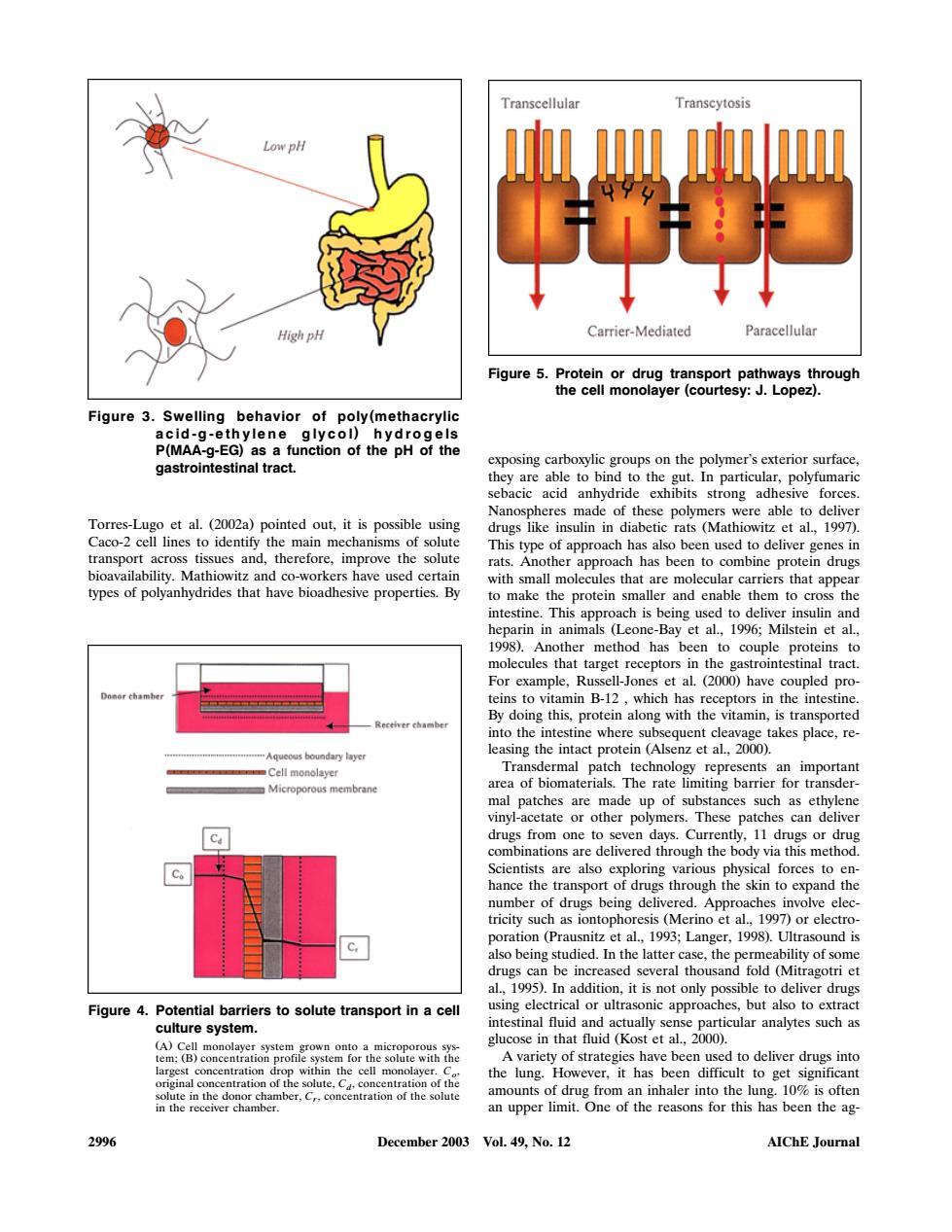正在加载图片...

Transcellular Transcytosi Low pH Carrier-Mediated Paracellula Fgure5.etenaool,eeo8tspPehtope2hrougn igure 3 beha gastrointe Torres-Lugo et al.(202a)pointed out,it is possible using aco-2 o make -Bay et al,1996;Milstein et al into the an imn of biomaterials.The rate r for trar These patches can deliver c nber of drugs bein ed Anpr tricity such 5)I ure 4.Potentia to solute rt in a ng electr culture system A)Cell monolayer syste th amounts of drug f 2996 December 2003 Vol.49.No.12 AIChE Journal Figure 3. Swelling behavior of poly methacrylic ( acid-g-ethylene glycol hydrogels ) P MAA-g-EG as a function of the pH of the ( ) gastrointestinal tract. Torres-Lugo et al. 2002a pointed out, it is possible using Ž . Caco-2 cell lines to identify the main mechanisms of solute transport across tissues and, therefore, improve the solute bioavailability. Mathiowitz and co-workers have used certain types of polyanhydrides that have bioadhesive properties. By Figure 4. Potential barriers to solute transport in a cell culture system. Ž . A Cell monolayer system grown onto a microporous system; B concentration profile system for the solute with the Ž . largest concentration drop within the cell monolayer. C , o original concentration of the solute, C , concentration of the d solute in the donor chamber, C , concentration of the solute r in the receiver chamber. Figure 5. Protein or drug transport pathways through the cell monolayer courtesy: J. Lopez . ( ) exposing carboxylic groups on the polymer’s exterior surface, they are able to bind to the gut. In particular, polyfumaric sebacic acid anhydride exhibits strong adhesive forces. Nanospheres made of these polymers were able to deliver drugs like insulin in diabetic rats Mathiowitz et al., 1997 . Ž . This type of approach has also been used to deliver genes in rats. Another approach has been to combine protein drugs with small molecules that are molecular carriers that appear to make the protein smaller and enable them to cross the intestine. This approach is being used to deliver insulin and heparin in animals Leone-Bay et al., 1996; Milstein et al., Ž 1998 . Another method has been to couple proteins to . molecules that target receptors in the gastrointestinal tract. For example, Russell-Jones et al. 2000 have coupled pro- Ž . teins to vitamin B-12 , which has receptors in the intestine. By doing this, protein along with the vitamin, is transported into the intestine where subsequent cleavage takes place, releasing the intact protein Alsenz et al., 2000 . Ž . Transdermal patch technology represents an important area of biomaterials. The rate limiting barrier for transdermal patches are made up of substances such as ethylene vinyl-acetate or other polymers. These patches can deliver drugs from one to seven days. Currently, 11 drugs or drug combinations are delivered through the body via this method. Scientists are also exploring various physical forces to enhance the transport of drugs through the skin to expand the number of drugs being delivered. Approaches involve electricity such as iontophoresis Merino et al., 1997 or electro- Ž . poration Prausnitz et al., 1993; Langer, 1998 . Ultrasound is Ž . also being studied. In the latter case, the permeability of some drugs can be increased several thousand fold Mitragotri et Ž al., 1995 . In addition, it is not only possible to deliver drugs . using electrical or ultrasonic approaches, but also to extract intestinal fluid and actually sense particular analytes such as glucose in that fluid Kost et al., 2000 . Ž . A variety of strategies have been used to deliver drugs into the lung. However, it has been difficult to get significant amounts of drug from an inhaler into the lung. 10% is often an upper limit. One of the reasons for this has been the ag- 2996 December 2003 Vol. 49, No. 12 AIChE Journal